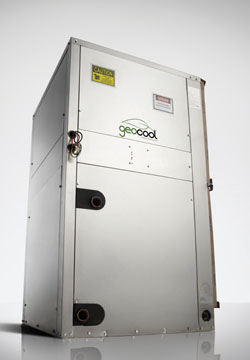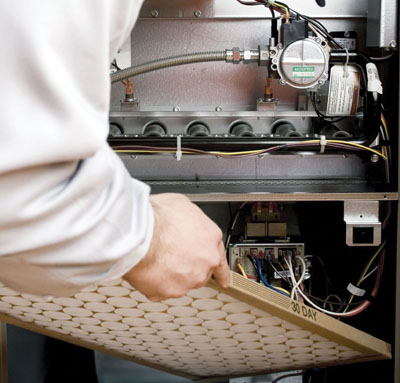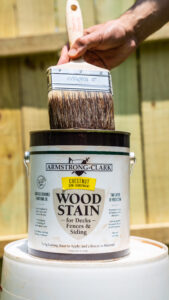By Matt Weber
Home buyers and home builders should know the ins and outs of their heating system. Here’s a cheat-sheet that covers differences among the standard central heating options, from fuel types to system setups.
Furnace
A furnace heats a home by pulling cool indoor air into the unit, heating it and then distributing the warmed air throughout the home via ductwork. Today, most furnaces today use natural gas, oil or electricity, and each system works a little differently.
With natural gas heating, the gas is mixed with air inside a burner and ignited inside a combustion chamber. In a forced-air system, a blower pulls cool air from the rooms through the air ducts and into the furnace. The air is heated by a heat exchanger connected to the combustion chamber, and the warm air then flows back into the house through ductwork. Exhaust gases from the burners are vented outside through the roof, or in some cases, a side-wall vent.
“Gas furnaces are the most common winter heating units in North America,” says Jason Ingram of Ingram’s Water and Air Equipment, a wholesale equipment supplier based in Paducah, Kentucky. “Dollar for dollar, they’re still the most effective option for many homeowners.”
An oil-fired furnace operates in a manner similar to gas, but the oil is atomized and then burned. Air absorbs heat in the exchanger, and a blower returns the warm air back through the house via the ductwork. Emissions are then vented outside.
Some homes are equipped with gravity furnaces that do not rely on forced air or blowers. Gravity furnaces are typically installed in basements and warm the home as heat naturally rises through the ducts.
An electric forced-air furnace uses a blower to move air over electrically-heated coils. The warm air is then distributed through the through ductwork. These units can be used with heat pumps or central air conditioners, and they require no venting.
Boiler
Boilers heat water that transports heat to radiators, baseboard heaters, hydronic radiant floor systems and more. The hot water of a boiler can heat an entire home or just certain zones, as well as provide consumable hot water to
a kitchen, bathroom, swimming pool or hot tub. A boiler can even provide the hot water for a radiant system installed beneath a driveway or sidewalks to melt ice and snow.
In a boiler, water is typically heated to a pre-set temperature between 160- to 180-degrees F. The hot water is then circulated by pumps through pipes in the home. This heated water then warms radiators and other fixtures installed throughout the home.
As the cool air in the room flows through the hot radiators, the air is warmed. As the heat from the water inside the radiator is released into the air, the water inside the radiator is cooled and returns back to the boiler to be reheated.
The primary energy source for modern residential boilers is oil or natural gas. Heat is created during the combustion process when air mixes with the fuel and is burned. Residential gas boilers typically use a pilot to ignite the flame, while oil burners are ignited using direct spark of the oil flame. In all cases, the burned fuel is exhausted to the outdoors.
The efficiency of both a boiler and furnace can be determined by its AFUE rating (Annual Fuel Utilization Efficiency). The Federal Trade Commission requires new furnaces or boiler manufacturers to display the system’s AFUE so consumers can compare heating efficiencies of various models.
“Remember, when it comes to AFUE, higher is always better,” notes Ingram.
The Department of Energy’s “Energy Star” qualified boilers have annual AFUE ratings of 85 percent or greater. The minimum efficiency level for furnaces currently manufactured in the U.S. is 80-percent AFUE. A rating of 80 percent means that for every dollar you spend heating your home, 80 cents are actually applied to the generation of warmth. The other 20 escapes up the chimney or elsewhere. For enhanced energy efficiency, you should consider a 95-percent AFUE unit.

Air-transfer heat pumps can provide both heating and cooling to maintain the indoor comfort of your home. In the summer, a heat pump functions as a central air conditioner. But in the winter, the heat pump reverses its action to create warm, comfortable air for your home.
A heat pump operates by transferring heat from air inside the home to the outside air. It has three main components: a compressor, a condenser and an evaporator coil. These parts are responsible for converting a chemical refrigerant from a gas to a liquid and back again. During the summer the indoor unit, which contains the evaporator coil, removes indoor warmth and humidity from the air. The outdoor unit, which contains the condenser and compressor, rejects the heat that was captured indoors.
A fan draws outdoor air through louvers surrounding the outdoor cabinet and blows air across the hot coil. As the air blows across the coil, it transfers the heat to the outside air and cools the refrigerant inside the coil.
When an air-source heat pump is heating your home, the cooling cycle is reversed. In the outdoor unit, the heat pump evaporates the low-temperature refrigerant. As the liquid evaporates, it absorbs heat from the outside air. (Even cold winter air contains heat.) After the gas is compressed in the outdoor unit’s compressor, it passes into the indoor coil and condenses, which releases heat inside the house.
“An energy-efficient heat pump is a great home HVAC system,” says Ingram. “Depending on where you live, it could be the only cooling and heating system you need.”
Some manufacturers offer a “package” heat pump. These all-in-one systems supply both cooling and heating equipment in a single “package” that sits on the ground or rooftop outside of your home, economizing space.

Hybrid Systems
Another approach to more energy-efficient heating is the use of hybrid HVAC systems that utilize two fuel sources for efficient heating and cooling, usually a gas furnace and an electric heat pump. These systems can present a more efficient means of using conventional power sources. The hybrid HVAC control system is calibrated to switch between the furnace and heat pump, depending on which is the most economical power source for your heating or cooling at any given time.
“Dual fuel systems can strike a good balance between efficiency and power,” says Ingram. “We typically recommend a dual fuel heat pump for maximum flexibility.”
Geothermal Heat Pumps
For the homeowner interested in “going green”, a geothermal heat pump is an environmentally friendly alternative to conventional heating appliances. Geothermal pumps are similar to air-source heat pumps in that they condition the air of a home using the transfer of heat. Geothermal power is extracted from heat stored in the earth. In principle, a geothermal pump functions like a conventional heat pump, by using high-pressure refrigerant to capture and move heat between the indoors and out. However, geothermal systems transfer heat through long loops of liquid-filled pipe that are buried in the ground (or a water source). Because the earth’s temperature stays right around 50 degrees, no matter what the weather is, geothermal systems can easily extract and disburse heat through the 50-degree liquid circulating in its ground loop. This provides a more stable source of heat than conventional heat pumps, which rely on the outside air as a heat source.
“If you want to maximize your efficiency and savings for the life of your home, you’ll never find a better system than a geothermal heat pump,” says Ingram. “They’re just amazing units.”
Geothermal pumps can be used for both forced-air applications and radiant floor applications. Not only do geothermal heat pumps exchange heat more efficiently, but they’re much better for the environment than traditional heat pumps due to the reduction in fossil fuel emissions.
Radiant Heating Systems
As an alternative to warm air systems, the technology for radiant heat flooring came to the United States from Europe. A heated floor will radiate heat outward to all areas of the room. During the cold seasons, radiant heat flooring can make the living space comfortable enough for shorts and bare feet in the middle of winter. Radiant systems are available in two types: hydronic and electric.
Hydronic systems generally feature 1/2-in. under-floor flexible PEX tubing that carries hot water across the floor. Hydronic systems can be powered by gas, oil, electricity or solar energy, making them making them more flexible and economical than electrical systems for whole-house applications.
Electric radiant systems use cables or thin under-floor mats that are wired to work much like electric blankets. These systems are often used to heat small areas such as kitchens, bathrooms and entryways. Electric systems are typically easier to install than hydronic systems and work well in many remodeling projects because many existing homes have electric heat, so it’s easier to maintain the same energy source.
“Radiant floor heating is a good way to make a bedroom or bathroom particularly cozy in winter,” says Ingram
The Right Size System
Before buying any new heating system or modifying your existing unit, first make every effort to improve the energy efficiency of your home, then have a heating contractor determine the size your system. Energy-efficient improvements will save money because you can purchase a smaller system. A properly sized furnace will operate most efficiently, and you’ll want to choose a dependable manufacturer and compare the warranties of each system you’re considering. When properly sizing a system for a home, a trained technician will use an equation that factors the home’s age, the number and quality of its windows, how well it is insulated, how many stories it has, its total square footage and local energy rates.
“When it comes to finding the right system, guess-ing just won’t do it. Absolutely insist your contractor perform a Manual J Calculation on your home,” suggests Ingram. The Manual J Calculation is the standard method of calculating heating and cooling loads endorsed by the Air Conditioning Contractors of America.
For more information on your home’s central heating system, visit the following resources:
Air Conditioning, Heating, and Refrigeration Institute: www.ahrinet.org
U.S. Department of Energy, www.energy.gov
SIDENOTE 1
The new SmartSource Inverter Geothermal Water Source Heat Pumps from Daikin McQuay are pushing the bounds of home-heating efficiency even further. The Daikin compressor modulates to match the load requirements, delivering only the required energy to satisfy the space conditions. Efficiency increases as the system unloads, driving the energy efficiency up while maintaining comfort in the living space by keeping the temperature closer to set point. Since most of the operating hours are under partial load conditions, the SmartSource Inverter can take advantage of low airflows while operating quietly at reduced energy levels.
“The new SmartSource Inverter Geothermal units from Daikin McQuay are some of the most energy-efficient HVAC units I’ve ever seen,” says Jason Ingram of Ingram’s Water and Air Equipment. “If you want the cutting edge of HVAC technology for your home, this is it, folks.”
Learn more about this new technology at www.ingramswaterandair.com.
SIDENOTE 2
Retrofitting your Furnace or Boiler
Furnaces and boilers can be retrofitted to increase their efficiency. Older furnace and boiler systems had efficiencies in the range of 56 to 70 percent, but modern conventional heating systems can achieve efficiencies as high as 97 percent, converting nearly all the fuel to useful heat for your home. Energy-efficient upgrades and a new high-efficiency heating system can feasibly cut your fuel bills and your furnace’s pollution output in half. However, the costs of a retrofit should be carefully weighed against the cost of a new boiler or furnace, especially if replacement is likely within a few years or if you wish to switch to a different system for other reasons, such as adding air conditioning. www.energy.gov
Other Heating Related Articles




